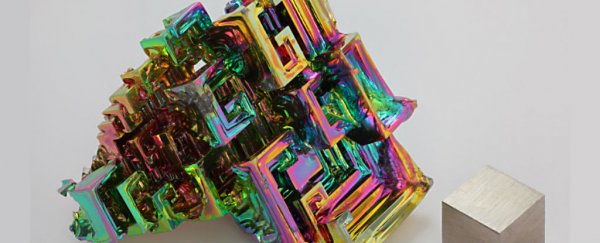Bismuth is one of the weirdest-looking elements on the Periodic Table, but its internal properties just got even stranger. Scientists have discovered that at a fraction of a degree above absolute zero (-273.15°C), bismuth becomes a superconductor - a material that can conduct electricity without resistance.
According to the current theory of superconductivity, that doesn't make a whole lot of sense, because for 40 years now, scientists have assumed that superconducting materials must be abundant in free-flowing mobile electrons. But in bismuth, there's just one mobile electron for every 100,000 atoms.
"In general, compounds that exhibit superconductivity have roughly one mobile electron per atom," Srinivasan Ramakrishnan from the Tata Institute of Fundamental Research in India explained to Chemistry World.
"However, in bismuth, one mobile electron is shared by 100,000 atoms – since [the] carrier density is so small, people did not believe bismuth will superconduct."
The 'carrier density' of a material describes the number of electrons per volume, and the discovery that bismuth has superconducting properties makes it the lowest carrier density superconductor ever found - breaking a 50-year record held by strontium titanate.
Despite the fact that, at room temperature, bismuth has incredibly high electrical resistance, with thermal conductivity levels that are lower than any metal, except mercury, scientists have been trying to discover superconductivity in it for decades.
Superconductivity gives materials the ability to carry an electric current with 100 percent efficiency, and if we could achieve that at room temperature, it would change the way we use electricity forever.
Unfortunately, scientists have struggled to get materials to transition into their superconducting form in anything other than incredibly frigid temperatures close to absolute zero (-273.15°C or -459.67°F).
So researchers have been cooling pure bismuth down to extremely low temperatures to see if it makes the transition, but once they got to the crazy low temperature of 0.01 kelvin (1°C = 274.15 K) and still found nothing, they gave up the chase.
"The last work done in bismuth found that it is not superconducting down to 0.01 kelvin. This was done 20 years ago and people gave up," Ramakrishnan told Vasudevan Mukunth at The Wire.
Ramakrishnan and his team decided to keep trying, and ended up finding that coveted superconducting property at 0.00053 kelvin. That's 5 ten-thousandths of a degree above absolute zero.
Researchers in the past have found superconducting properties in impure or amorphous (not crystalline) forms of bismuth, but only at very high pressures. This is the first sign of superconducting bismuth in its normal form, and at ambient pressures.
While 0.00053 kelvin isn't exactly a practical temperature to achieve superconductivity at - scientists around the globe are working feverishly to achieve superconductivity in any material at room temperature - the fact that bismuth is a superconductor at any temperature is strange.
According to the Bardeen-Cooper-Schrieffer theory (or BCS theory) of superconductivity, for which the 1972 Nobel Prize in Physics was awarded, the phenomenon is achieved when mobile electrons come together in pairs and flow through the material undisturbed.
"To be able to conduct electricity, the atoms of a metal must have some mobile electrons that can move throughout the metal instead of being trapped around the atoms.
In superconducting metals that have been cooled to low temperatures, these electrons overcome the repulsion due to their 'like' charges, come together, and form pairs. The sea of electron-pairs around the metal then flow as one like a fluid, and refuse to be jolted out of their reverie by vibrating atoms unless the metal is warmed up beyond a threshold temperature."
But how can superconductivity be sustained in bismuth, with just one mobile electron for every 100,000 atoms?
If you applied the BCS theory of superconductivity to bismuth, it predicts that the phenomenon could only occur at temperatures 1,000 times lower than 0.00053 kelvin - an almost unfathomably cold state.
"This carrier density is so small that, if we establish superconductivity [in bismuth], the conventional BCS theory cannot explain it," Ramakrishnan said. "Now we need a new mechanism for superconductivity in bismuth."
While the team doesn't expect that the current theory of superconductivity will need to be overhauled in order to explain bismuth's behaviour, they say certain aspects of it will now need to be 'filled in' with further theoretical work to explain how extremely low carrier density superconductors work.
The research has been published in Science, and you can read it for free at arXiv.org.
